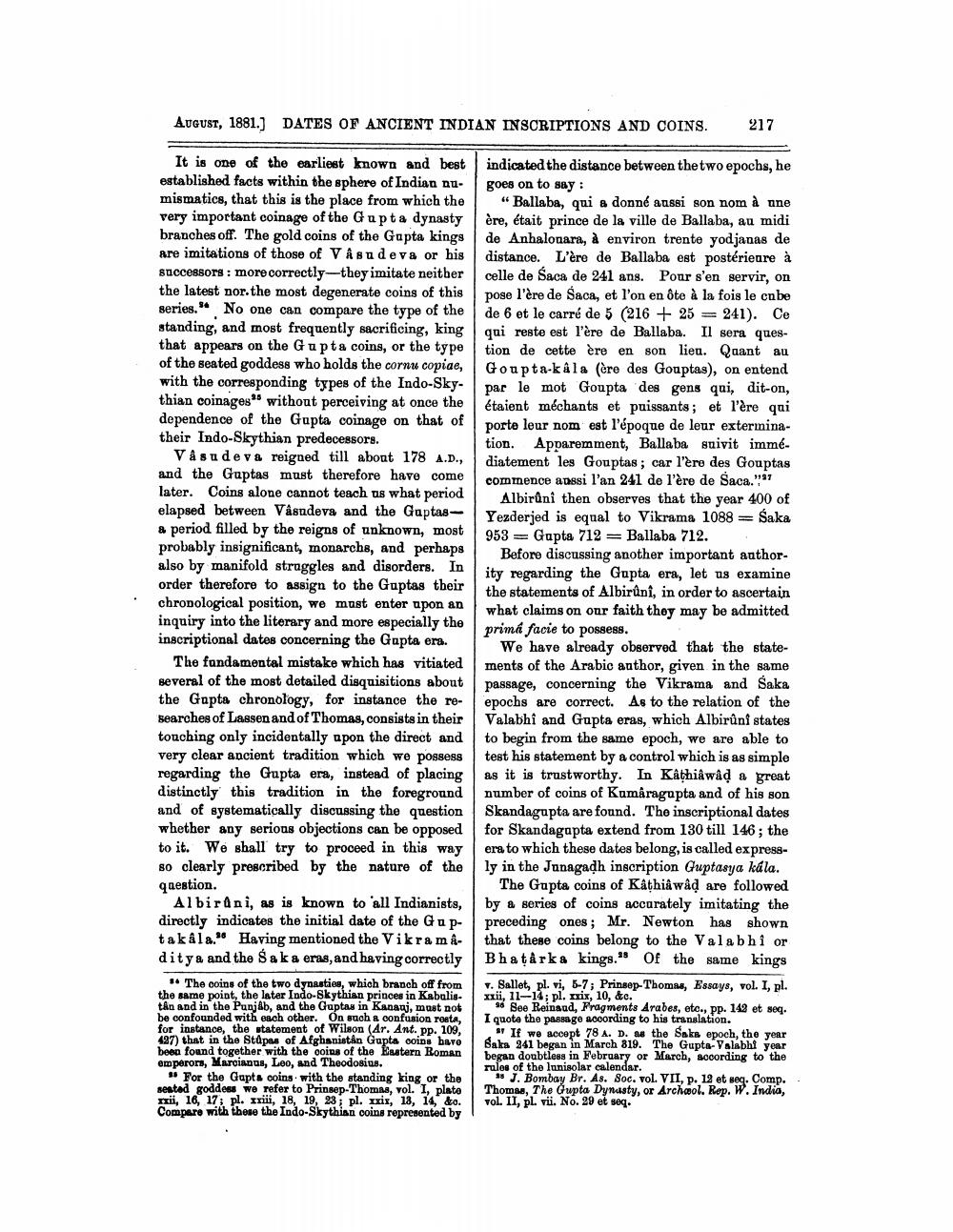________________
AUGUST, 1881.) DATES OF ANCIENT INDIAN INSCRIPTIONS AND COINS.
217
It is one of the earliest known and best established facts within the sphere of Indian nu. mismatics, that this is the place from which the very important coinage of the Gupta dynasty branches off. The gold coins of the Gupta kings are imitations of those of VÁsudeva or his successors : more correctly-they imitate neither the latest nor the most degenerate coins of this series." No one can compare the type of the standing, and most frequently sacrificing, king that appears on the Gupta coins, or the type of the seated goddess who holds the cornu copiae, with the corresponding types of the Indo-Sky- thian coinages" without perceiving at once the dependence of the Gupta coinage on that of their Indo-Skythian predecessors.
Vasudeva reigned till about 178 A.D., and the Guptas must therefore have come later. Coins alone cannot teach us what period elapsed between Vasudeva and the Gaptas& period filled by the reigns of unknown, most probably insignificant, monarchs, and perhaps also by manifold struggles and disorders. In order therefore to assign to the Guptas their chronological position, we must enter upon an inquiry into the literary and more especially the inscriptional dates concerning the Gupta era.
The fundamental mistake which has vitiated Beveral of the most detailed disquisitions about the Gapta chronology, for instance the researches of Lassen and of Thomas, consists in their touching only incidentally upon the direct and very clear ancient tradition which we possess regarding the Gupta era, instead of placing distinctly this tradition in the foreground and of systematically discussing the question whether any serious objections can be opposed to it. We shall try to proceed in this way so clearly prescribed by the nature of the question.
Albirani, as is known to all Indianists, directly indicates the initial date of the Gaptakala." Having mentioned the Vikra má ditya and the Saka eras, and having correctly
The coins of the two dynasties, which branch off from the same point, the later Indo-Skythian princes in Kabalistan and in the Punjab, and the Guptas in Kanagj, must not be confounded with each other. On such a confusion rosta, for instance, the statement of Wilson (Ar. Ant. pp. 109, 427) that in the Stapes of Afghanistan Gupta coins havo been found together with the coins of the Eastern Roman emperors, Marcianus, Leo, and Theodosius.
For the Gupta coins with the standing king or the sented goddess we refer to Prinsep-Thomas, vol. I, plate rxii, 16, 17, pl. riii, 18, 19, 23 pl. xxix, 13, 14, &o. Compare with those the Indo-Skythian coins represented by
indicated the distance between the two epochs, he goes on to say:
"Ballaba, qui a donné aussi son nom à une ère, était prince de la ville de Ballaba, au midi de Anhalonara, à environ trente yodjanas de distance. L'ère de Ballaba est postérieure à celle de Saca de 241 ans. Pour s'en servir, on pose l'ère de Saca, et l'on en ête à la fois le cnbe de 6 et le carré de 5 (216 + 25 = 241). Ce qui reste est l'ère de Ballaba. Il sera question de cette ère en son lieu. Quant au Goupta-kåla (ère des Gouptas), on entend par le mot Goupta des gens qui, dit-on, étaient méchants et puissants; et l'ère qui porte leur nom est l'époque de leur extermination. Apparemment, Ballaba suivit immé. diatement les Gouptas; car l'ère des Gouptas commence aussi l'an 241 de l'ère de Saca."
Albirûni then observes that the year 400 of Yezderjed is equal to Vikrama 1088 = Saka 953 = Gupta 712 = Ballaba 712.
Before discussing another important author. ity regarding the Gupta era, let us examine the statements of Albirûnî, in order to ascertain what claims on our faith they may be admitted prima facie to possess.
We have already observed that the statements of the Arabic author, given in the same passage, concerning the Vikrama and Saka epochs are correct. As to the relation of the Valabhi and Gupta eras, which Albirûni states to begin from the same epoch, we are able to test his statement by a control which is as simple as it is trustworthy. In Kathiâwâd a great number of coins of Kumaragupta and of his son Skandagupta are found. The inscriptional dates for Skandagapta extend from 130 till 146; the era to which these dates belong, is called expressly in the Junagadh inscription Guptasya kula.
The Gupta coins of Kathiâwâd are followed by a series of coins accurately imitating the preceding ones; Mr. Newton has shown that these coins belong to the Valabhi or Bhatarka kings." Of the same kings . Sallet, pl. vi, 5-7; Prinsep-Thomas, Essays, vol. I, pl. xxii, 11-14; pl. xxix, 10, &c.
9 Bee Reinaud, Fragments Arabes, etc., pp. 142 et seq. I quote the passage according to his translation.
If we accept 78 A. D. as the sake opoch, the year Baka 241 began in March 819. The Gupta-Valabhl year began doubtless in February or March, woording to the rules of the lunisolar calendar.
* J. Bombay Br. As. Soc. vol. VII, p. 12 et seq. Comp. Thomas, The Gupta Dynusty, or Archæol. Rep. W. India, vol. II, pl. vii. No. 29 et seq.




